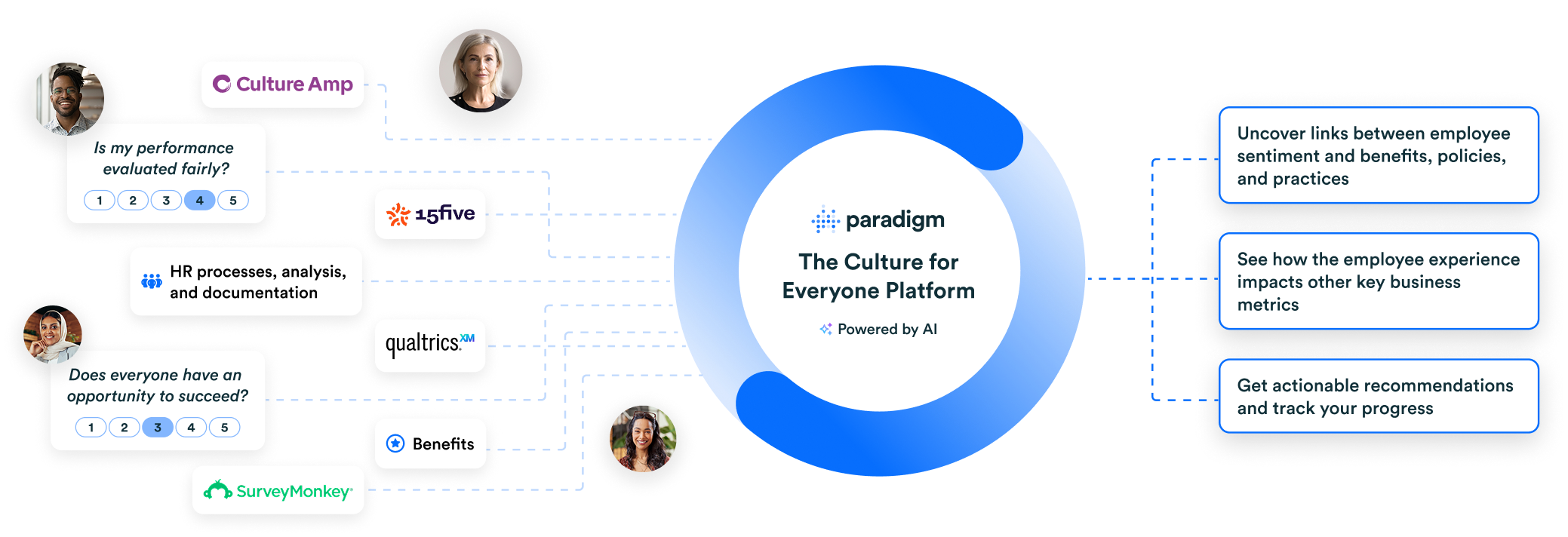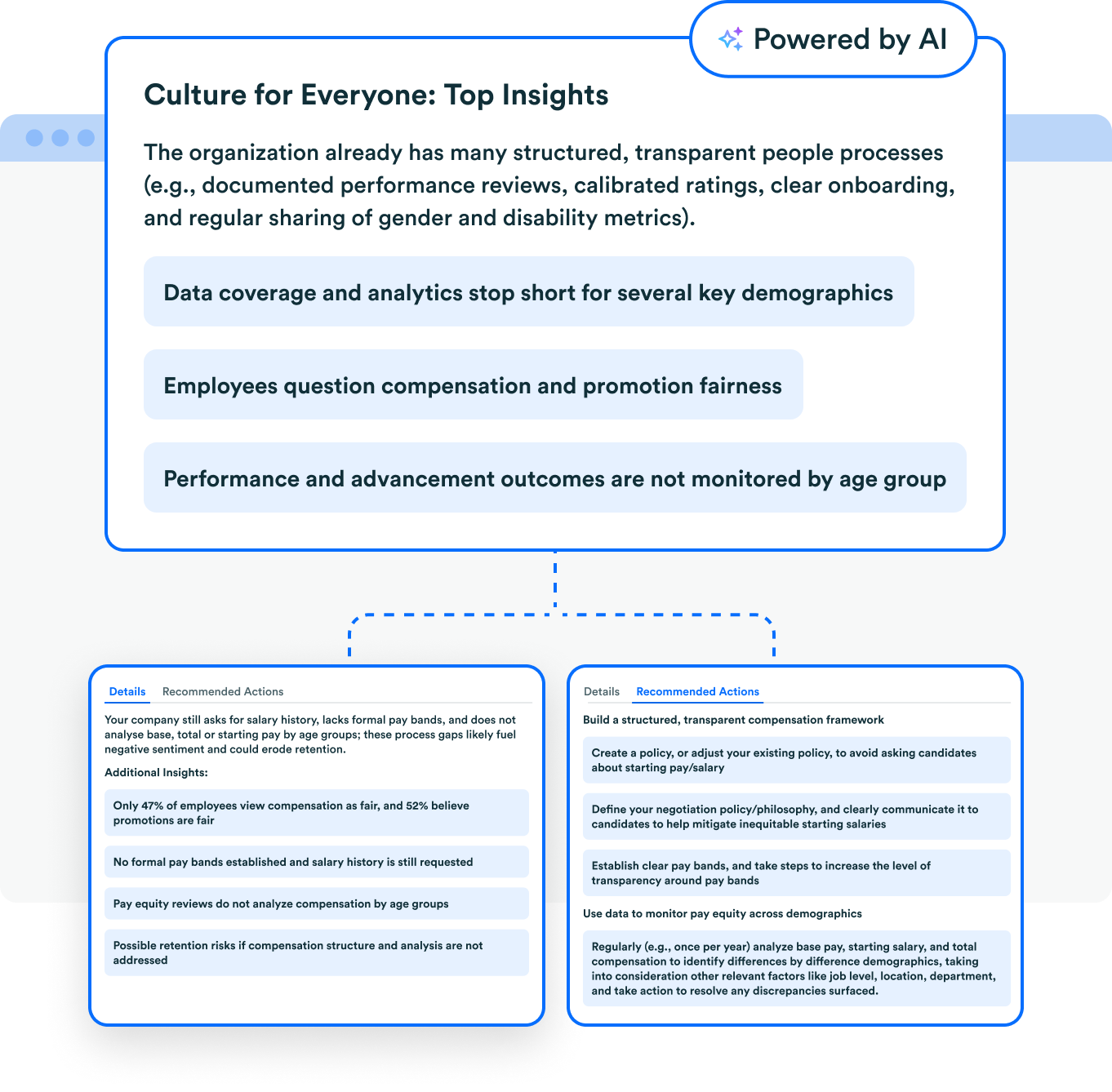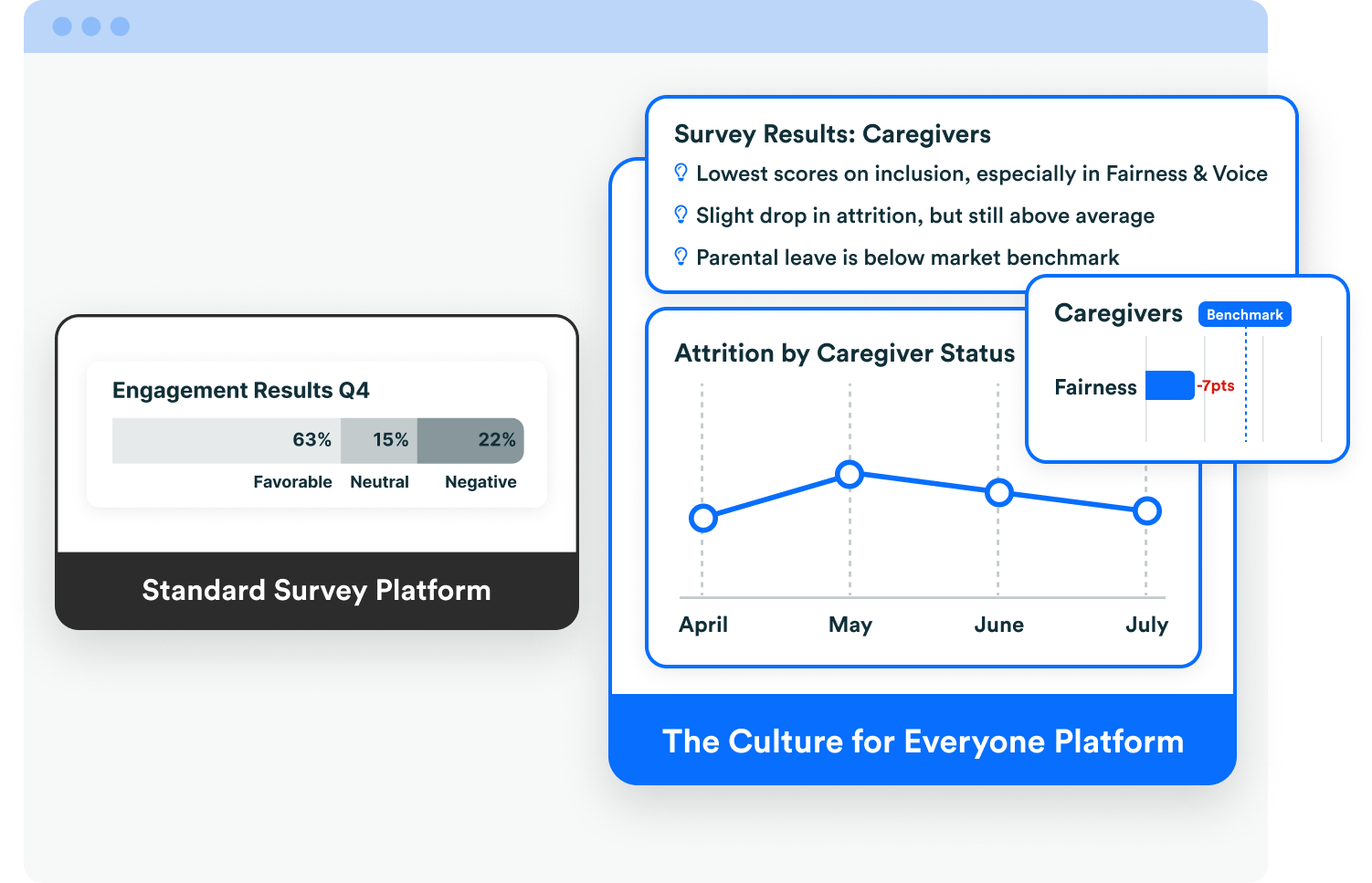From Pulse Check to Progress: Getting the Most From Employee Surveys
If you’re like most organizations, you run an engagement survey at least once a year to get a pulse on your culture. While the vast majority of companies do employee surveys, very few maximize their potential. Most look at a high-level, aggregate results, review the data by team, and set a goal to improve. But few organizations use this data to improve their culture, and many struggle to consider how employee sentiment data should be used alongside other data
That’s where Paradigm comes in: we work with clients to pair research-backed survey design with an AI-powered intelligence layer that connects your survey results to the rest of your organizational data (e.g., promotion trends, exit feedback, and more). The payoff? Patterns you can see sooner, stories you can tell clearly, and actions you can prioritize with confidence.
Surveys Are Just The Start
Asking the right questions, collecting the right data, and getting employees to participate are all essential. We’ve been helping companies do this effectively for more than a decade, both through our own surveys or the templates we’ve partnered with Momentive and Culture Amp to build.
With the emergence of AI, we see a huge opportunity for companies to more effectively analyze their survey results in the context of their broader organizational maturity and data, and to take meaningful action. Looking at employee sentiment in a vacuum can only tell you so much: how people feel is an outcome of inputs like your talent practices, cultural norms, employee benefits, and more. And if you look at sentiment without looking at other objective metrics, like how people are moving through your organization, or who’s staying and who’s leaving, it’s hard to make sense of how consequential the patterns you’re seeing really are, and how to best take action to improve.
Real insights — those that allow you to make changes that meaningfully improve key business outcomes and create cultures where everyone can thrive — emerge when you layer survey data onto other key data sources:
- Benefits, policies & processes: Do low perceptions of fairness map to opaque promotion criteria? Are some employees’ experiencing lower sentiment in areas where your benefits are off market, or your policies are less mature?
- Attrition & mobility: Do certain populations score lower in particular themes before their attrition rate spikes? Do lower scores in key areas align with less internal mobility?
- Hiring & offer acceptance: Are teams with lower scores also seeing slower time-to-fill or higher offer declines?
Paradigm’s Culture for Everyone uses AI to help make these connections, and give you guidance on how to take action, in minutes, not months.

Ultimately, connecting employee sentiment data to other key markers of culture gives HR leaders the three things they need most when it comes to translating survey data to actionable culture strategies:
- Speed: Insights update in real-time as new data flow in, not in a PDF three weeks later. If a new attrition pattern is emerging that connects to key sentiment data, you’ll know today — not in 2 months.
- Signal. We focus on surfacing meaningful patterns and relationships, not just high level readouts.
- Standards. We help you benchmark your policies and benefits against peers. If your offerings are less mature than the market and that gap appears to be affecting employee sentiment, we’ll flag it, keep you up-to-date on evolving benchmarks, and recommend where to focus for the biggest impact.
- Story. We help you craft clear narratives and next steps for executives, managers, and employees: “Here’s the gap, here’s why it matters, here’s what we’re doing.”
How We Make It Happen
Inclusive, High-Quality Survey Design
We’ve not only acted as expert advisors in developing the most popular employee survey templates for other top survey companies, we’ve also spent more than a decade designing our own proprietary survey. In it, we center outcomes: What decisions are you trying to inform? Which concepts—fairness, belonging, voice, psychological safety—matter most to your organization? We use validated items and scales to help you gather rich demographic data in a compliant, confidential way so you can uncover key differences and target support.
AI That Connects Dots Across Datasets
Whether you use our survey, a third-party vendor, or something you’ve built in-house, Paradigm’s Culture for Everyone platform can ingest your survey results, using our AI intelligence layer to analyze your employee sentiment data alongside other key data points including attrition, hiring, policies, benefits, and more. It then:
- Uncovers gaps across identities, teams, and levels
- Links those gaps to business outcomes (e.g., retention, hiring trends, productivity proxies)
- Prioritizes actions by likely impact
- Provides executive-level insights and recommendations that leaders can actually use
Action, Accountability, and Iteration
We don’t stop at insights. We also help you roll out transparent communications, equip leaders with targeted playbooks, and track whether the things you’re doing are closing gaps, so you can adjust quickly.

What It Looks Like In Action
A high-growth tech company’s* survey revealed that perceptions of fairness scores were lagging for mid-level women of color. Our AI linked those scores to two signals: ambiguous promotion criteria and lower internal mobility for that group.
Within six months, the company:
- Used our recommendations to publish transparent promotions processes and manager toolkits.
- Trained leaders on inclusive performance management.
- Set up quarterly pulse checks on sentiment and mobility and used insights from our platform to iterate as new data came in.
A year later, objectivity scores for the group rose and attrition dropped by a third. This is typical of the flywheel we help clients build—insight, intervention, impact, repeat.
Another company*—a global professional services firm—found significant generational differences in engagement. Gen Z employees scored notably lower on engagement and belonging. Our AI intelligence layer connected these findings to two challenges: less access to stretch assignments and limited manager check-ins for early-career employees.
To close the gap, the company:
- Introduced structured mentorship and peer-learning programs tailored for early-career employees.
- Equipped managers with playbooks for more frequent, meaningful check-ins.
- Benchmarked their career development practices against industry peers to ensure competitiveness.
Six months later, Gen Z sentiment on engagement and belonging had improved by 20%, and the firm reported a measurable uptick in retention for early-career hires.
*We keep individual client data confidential, these are examples.
Want To Learn More?
We’d love to support your survey efforts:
- Sign up for a free demo of our platform here.
- Download our “5 Steps for Effective Employee Surveys” resource here. It covers question design, demographic data collection, and rollout tactics—everything you need to get the mechanics right.
- Sign up for our September 11 webinar on surveys here.
July 31, 2025

 Our website uses cookies to distinguish you from other users of our website. This helps us to provide you with a good experience when you browse our website and also allows us to
improve our site. By continuing to browse our website, you’re agreeing to our use of cookies. For more information, please read our
Our website uses cookies to distinguish you from other users of our website. This helps us to provide you with a good experience when you browse our website and also allows us to
improve our site. By continuing to browse our website, you’re agreeing to our use of cookies. For more information, please read our

